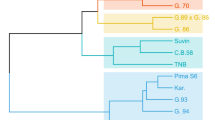Abstract
Selecting high yielding upland cotton, Gossypium hirsutum L. lines with improved fiber quality is a primary breeding goal. A diverse set of ten cultivars and one breeding line were crossed in a half diallel. Parents and F2 hybrids were grown in three environments at Mississippi State, MS. Ten agronomic and fiber traits were analyzed by a mixed linear model approach based on the additive-dominance genetic model. Variance component, genetic effects and genetic correlations were calculated. ‘Acala Ultima’ was a desirable general combiner for fiber length, uniformity, strength, micronaire, lint percentage, and boll weight. ‘FiberMax 966’ was a desirable general combiner for fiber length, uniformity, strength, and all agronomic traits. ‘Tamcot Pyramid’ and M240 were poor general combiners for both fiber and agronomic traits. ‘Coker 315’ was a good general combiner for fiber length, uniformity, micronaire, boll weight, boll number, and yield. Heterozygous dominance effects were associated with several crosses, which suggest their use as hybrids.
Similar content being viewed by others
Abbreviations
- UHM:
-
Mean length of upper 50% of fibers in mm
- UR:
-
Fiber uniformity ratio in %
- T1:
-
Fiber strength in kN m kg−1
- E1:
-
Fiber elongation in %
- MIC:
-
Fiber micronaire
- HVI:
-
High volume instrument measurement
- MINIQUE:
-
Minimum norm quadratic unbiased estimation
- AUP:
-
Adjusted unbiased prediction
References
Bowman DT, Gutierrez OA, Percy RG, Calhoun DS, May OL (2006) Pedigrees of upland and pima cotton cultivars released between 1970 and 2005. Bulletin 1155, Mississippi Agricultural and Forestry Experiment Station, 57 p
Cheatham CL, Jenkins JN, McCarty JC Jr, Watson CE, Wu J (2003) Genetic variance and combining ability of crosses of American cultivars, Australian cultivars, and wild cottons. J Cotton Sci 7:16–22
Cockerham CC (1980) Random and fixed effects in plant genetics. Theor Appl Genet 56:119–131
Jenkins JN, Wu J, McCarty JC Jr, Saha S, Gutierrez OA, Hayes R, Stelly D (2006) Genetic effects of thirteen Gossypium barbadense L. chromosome substitution lines in topcrosses with upland cultivars: I. Yield and yield components. Crop Sci 46:1169–1178
Jenkins JN, Wu J, McCarty JC Jr, Saha S, Gutierrez OA, Hayes R, Stelly D (2007) Genetic effects of thirteen Gossypium hirsutum L. chromosome substitution lines in topcrosses with upland cultivars: II. Fiber quality traits. Crop Sci 47:561–572
Jenkins JN, McCarty JC Jr, Gutierrez OA, Hayes RW, Bowman DT, Watson CE, Jones DC (2008) Registration of RMUP-C5, a random mated population of Upland cotton germplasm. J Plant Regist 2(3):239–242
McCarty JC Jr, Jenkins JN, Zhu J (1998a) Introgression of day-neutral genes in primitive cotton accessions: I. Genetic variances and correlations. Crop Sci 38:1425–1428
McCarty JC Jr, Jenkins JN, Zhu J (1998b) Introgression of day-neutral genes in primitive cotton accessions: II. Predicted genetic effects. Crop Sci 38:1428–1431
McCarty JC Jr, Jenkins JN, Wu J (2004a) Primitive accession germplasm by cultivar crosses as sources for cotton improvement I: phenotypic values and variance components. Crop Sci 44:1226–1230
McCarty JC Jr, Jenkins JN, Wu J (2004b) Primitive accession derived germplasm by cultivar crosses as sources for cotton improvement: II. Genetic effects and genotypic values. Crop Sci 44:1231–1235
Meredith WR (1984) Quantitative genetics. In: Kohel RJ, Lewis CF (eds) Cotton. ASA, CSSA, and SSSA, Madison, pp 131–150
Meredith WR (1990) Yield and fiber-quality potential for second generation hybrids. Crop Sci 30:1045–1048
Miller RG (1974) The jackknife: a review. Biometrika 61:1–15
Rao CR (1971) Estimation of variance and covariance components MINQUE theory. J Multivar Anal 1:257–275
Saha S, Jenkins JN, Wu J, McCarty JC Jr, Gutiérrez OA, Percy RG, Cantrell RG, Stelly D (2006) Effects of chromosome-specific introgression in upland cotton on fiber and agronomic traits. Genetics 172:1927–1938
SAS Institute (1999) SAS software version 9.0. SAS Institute, Cary
Shepherd RL, McCarty JC Jr, Jenkins JN, Parrott WL (1996) Registration of nine cotton germplasm lines resistant to root knot nematode. Crop Sci 36:820
Tang B, Jenkins JN, McCarty JC Jr, Watson CE (1993a) F2 hybrids of host plant germplasm and cotton cultivars: I. Heterosis and combining ability for lint yield and yield components. Crop Sci 33:700–705
Tang B, Jenkins JN, McCarty JC Jr, Watson CE (1993b) F2 hybrids of host plant germplasm and cotton cultivars: II. Heterosis and combining ability for fiber properties. Crop Sci 33:706–710
Tang B, Jenkins JN, Watson CE, McCarty JC Jr, Creech RG (1996) Evaluation of genetic variances, heritabilities, and correlations for yield and fiber traits among cotton F2 hybrid populations. Euphytica 91:315–322
Thaxton PM, El-Zik KM (2004) Registration of Tamcot Pyramid. Crop Sci 44:343
Wu J, Zhu J, Xu F, Ji D (1995) Analysis of genetic effect × environment interactions for yield traits in upland cotton (Chinese). Heredita 17(5):1–4
Zhu J (1989) Estimation of genetic variance components in the general mixed model. PhD dissertation, North Carolina State University, Raleigh, USA (Diss Abstr: DA8924291)
Zhu J (1993) Methods of predicting genotype value and heterosis for offspring of hybrids. J Biomath 8(1):32–44 (Chinese)
Acknowledgment
Partial support for this research was provided by Cotton Incorporated, Cary, NC.
Disclaimer
Mention of trademark or proprietary product does not constitute a guarantee or warranty of the product by the United States Department of Agriculture and does not imply its approval to the exclusion of other products that may also be suitable.
Author information
Authors and Affiliations
Corresponding author
Rights and permissions
About this article
Cite this article
Jenkins, J.N., McCarty, J.C., Wu, J. et al. Genetic variance components and genetic effects among eleven diverse upland cotton lines and their F2 hybrids. Euphytica 167, 397–408 (2009). https://doi.org/10.1007/s10681-009-9902-y
Received:
Accepted:
Published:
Issue Date:
DOI: https://doi.org/10.1007/s10681-009-9902-y



